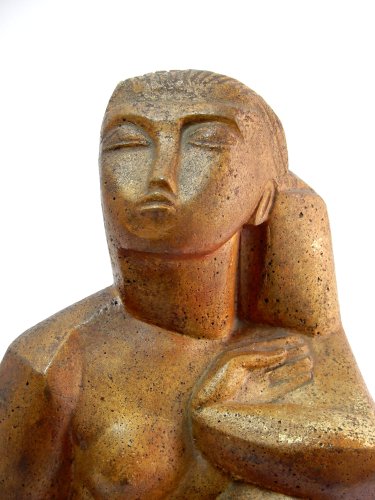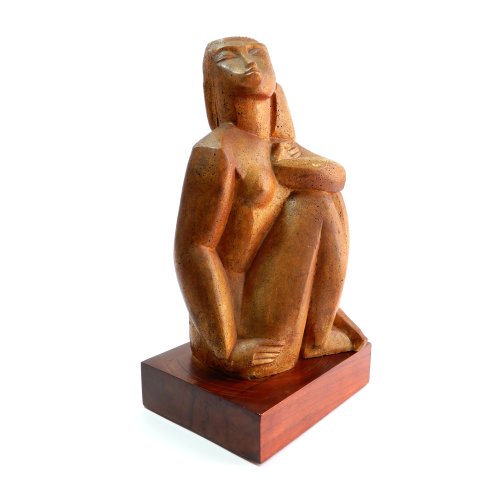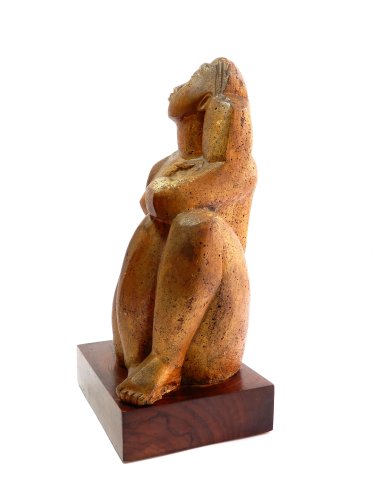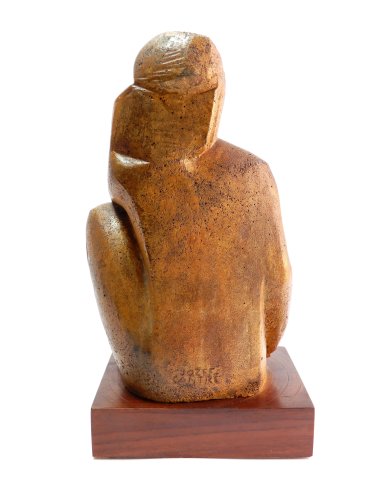Jozef Cantré (1890-1957) Meditation
About this piece
Beautiful sculpture by the Ghent artist Jozef Cantré. He created this sculpture of a meditating woman in 1925. He himself named the sculpture 'Meditation,' and to me, it also evokes an image of a woman enjoying the sun on her face.
At that time, Jozef Cantré lived in the Netherlands from 1918 to 1930 and exhibited at the well-known Hotel Hamdorff in Laren, a gathering place for artists. This sculpture was purchased there at the time and remained in the possession of the same family for many years.
Jozef Cantré is one of the founders of Flemish expressionism and is considered Belgium's most expressionist sculptor, as evident in this work with powerful lines and a strong cubist approach. Jozef Cantré was inspired by Ossip Zadkine, whom he got to know well during his stay in the Netherlands. He was also influenced by German expressionist movements such as 'die Brücke' and 'der Blaue Reiter.'
The sculpture is made of gilded concrete, and the previous owner told me that it is made of a special composition, metallized concrete mortar, an invention of John Rädecker at that time. Jozef Cantré was good friends with John Rädecker.
Biography:
Biography:
Jozef Cantré (Ghent, 1890-1957) was a Belgian sculptor, graphic artist, and draftsman. He received his education at the Academy of Fine Arts in Ghent under sculptors F. Metdepenninghen and Jean Delvin, who also taught Gustave De Smet, Frits van den Berghe, and Albert Servaes. Starting from 1909, he focused into book decoration and woodcutting. Cantré illustrated works by notable authors such as Karel van de Woestijne, Stijn Streuvels, Ernest Claes, and Hendrik Marsman.
Jozef Cantré, along with his brother Jan-Frans Cantré, Frans Masereel, Henri van Straeten, and Joris Minne, belonged to 'De Vijf' (The Five), a group of graphic artists who revolutionized Flemish woodcut art.
During the same period, he drew inspiration from sculptors Georges Minne and Constantin Meunier and was associated with the artistic community in Sint-Martens-Latem, although he officially never resided there, unlike his friends Frits van den Berghe, Gustave and Leon De Smet, Constant Permeke, and Albert Servaes. Cantré, living just a few kilometers away, frequented the colony almost daily. These artists laid the foundation for expressionism in Flanders, a movement that flourished further when Frits van den Berghe, Gustave De Smet, André de Ridder, and Jozef Cantré stayed in the Netherlands during and after World War I. They are rightfully regarded as the pioneers of Flemish Expressionism.
Jozef Cantré was a reserved yet socially engaged figure. Known for his hospitality and humor, he enjoyed telling jokes and held a deep appreciation for nature, art, books, and politics. He was an intellectual.
Active in the Young Socialists, Cantré was also a pacifist. He advocated for the independence of Flanders, preferably in union with the Netherlands to form Greater Netherlands. During World War I, he attended the Vlaamse Hogeschool, a forbidden institution, making him a criminal by law. He was sentenced to five years in prison in absentia. By then, he was already in the Netherlands, where his friends resided. It wasn't until 1929, with a general amnesty law, that he could return to Belgium.
Cantré harbored a deep affection for the Netherlands—the language, the people, and the artists. During his 12 years in Laren, he made numerous friends, including the physician and artist Hendrik Wiegersma. Through Wiegersma, he became acquainted with Ossip Zadkine, with whom he immediately connected. Both artists preferred working directly in stone or wood ('taille directe') without creating a clay model first. They shared stylistic similarities and intellectual prowess.
Cantré also befriended many Dutch sculptors, including John Raedecker. The sculpture 'Meditating' is made of gilded concrete, referred to as metallized concrete by Raedecker, who developed the recipe himself.
During his stay in the Netherlands, Cantré and his friends maintained close ties with the Belgian art scene, with Cantré's wife serving as a courier. They were members of the Sélection group, founded in 1921. Notably, the poet René de Clercq played a significant role as he established an art dealership, showcasing the work of Flemish exiles to collectors. Cantré paid homage to René de Clercq by creating a memorial statue for his grave in 1936.
Cantré's woodcut art, particularly the graphic pieces, played a crucial role in his income. He crafted numerous illustrations for books, and his graphic work is highly regarded, featuring in many museum collections.
Upon his return to Belgium in 1930, Cantré faced financial challenges, systematically being excluded from commissions. However, a turning point came in 1938 when a competition was announced for a memorial to Anseele, a socialist leader. Cantré's design stood out, facing considerable opposition from the radical right. Eventually, Cantré secured the commission, resulting in an impressive monument that earned him widespread acclaim. Subsequently, he began receiving more commissions, including public works.
His most prolific years in sculpture were from 1918 to 1938, according to experts. The MUDEL Museum (Museum of Deinze and the Leie Region) held a significant exhibition on Jozef Cantré in 2018, focusing on the period 1918-1938. His work from this time is described as 'stylistically pure expressionism with direct expression, clarity of lines, and minimal emphasized accents.'
In 1952, Jozef Cantré received the Angelo Award for engraving at the 16th Venice Biennale. His sculptures adorn buildings and public spaces in various cities. His works and statues are featured in numerous museums, including those in Brussels, Ghent, Antwerp, Deinze, Liège, Utrecht, The Hague, and Rotterdam.
Jozef Cantré passed away in 1954 at the age of 66.
Literature:
- A.E. van Tol; "Jozef Cantré en zijn werk", Elseviers Geïllustreerd Maandschrift, jaargang 36, januari-juni 1926.
- Peter J.H. Pauwels; 'Jozef Cantré, Beeldhouwer & Houtsnijder', MUDEL (Museum van Deinze en de Leiestreek), 2018.
-
'Beeldhouwkunst in België vanaf 1830', Engelen-Marx, Uitgeverij Studia,
Algemeen Rijksarchief Brussel, 2002. Deel 1, p. 208-211.
Condition
Uitstekend
Material:
Verguld beton
Measurements:
Sculpture:
Height: 31 cm
(12,2")
Including the base:
Height: 36 cm
(14,17")
Year:
1925
Origin:
the Netherlands
Artist / atelier:
Jozef Cantré,













